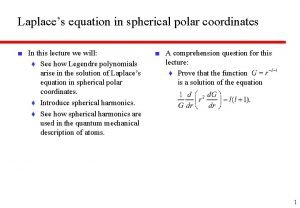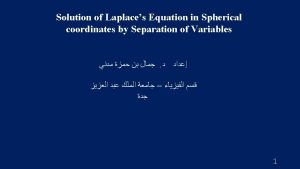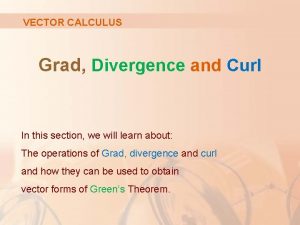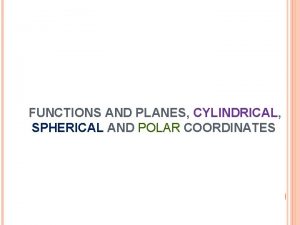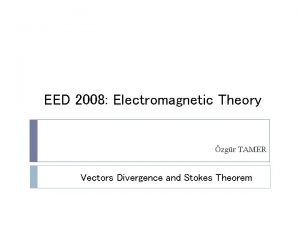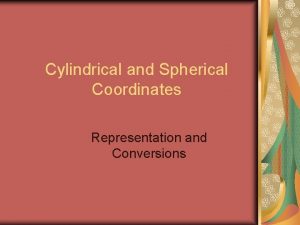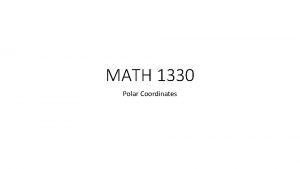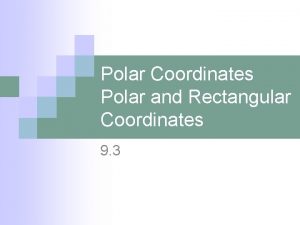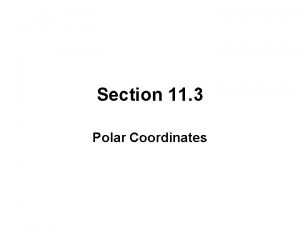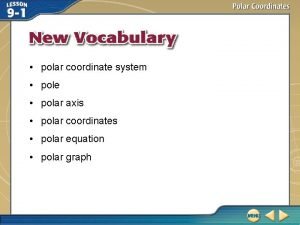Laplaces equation in spherical polar coordinates In this







- Slides: 7

Laplace’s equation in spherical polar coordinates ■ In this lecture we will: ♦ See how Legendre polynomials arise in the solution of Laplace’s equation in spherical polar coordinates. ♦ Introduce spherical harmonics. ♦ See how spherical harmonics are used in the quantum mechanical description of atoms. ■ A comprehension question for this lecture: ♦ Prove that the function is a solution of the equation 1

Laplace’s equation in spherical polar coordinates ■ In spherical polar coordinates, the gradient is: ■ The divergence is: ■ Putting them together, we get the Laplacian in spherical polar coordinates: ■ Setting this expression equal to zero gives us Laplace’s equation in spherical polar coordinates: ■ Lots of physical potentials are described by this equation and many of them depend on r and q, but not on f. ■ Look for solutions to Laplace’s equation that are independent of f. ■ Also assume we can solve by separating variables, i. e. that 2

Solving Laplace’s equation by separating variables ■ We can then rewrite the equation as: ■ Two solutions of this equation are: ■ Prove that is a solution of ■ The only way that a function of r and a function of q can be equal for all values of r and q is if they are both equal to the same constant. ■ Write that constant as (We will see later why this form is chosen!) ■ We then have: 3

Solving Laplace’s equation by separating variables ■ Also: Change variables by setting ■ This gives: ■ We then have: ■ Rearranging: ■ Differentiating w. r. t. w gives: ■ This is Legendre’s equation (with l instead of n)! ■ The solutions of this equation are the Legendre polynomials ■ The solutions of the Laplace equation (without f dependence) are therefore: 4

Spherical harmonics ■ If we allow f dependence, the Laplace equation can still be solved by separating variables; the angular part of the solution is given by the spherical harmonics: Wikimedia ■ The picture shows the first few real spherical harmonics ■ The distance from the origin shows the value of direction, with blue being positive and yellow negative. 5

Schrödinger’s equation for an H-like atom ■ Schrödinger’s equation describing an electron moving around a nucleus is: ■ The magnetic quantum number m is restricted to the range ■ The solutions are of the form: ■ The energy , i. e. it can only take on discrete values. ■ The value of l is limited by ■ The magnitude of the orbital angular momentum of the electron is given by ■ The z component of the orbital angular momentum is given by Wikimedia 6

Schrödinger’s equation for an H-like atom ■ The value of n, is called the principal quantum number. ■ If an electron shifts from an orbit with to one with , it emits (or absorbs) an energy: ■ As , this means energy is emitted from atoms at particular frequencies/wavelengths. ■ As the nuclear charge of (and the number of electrons in) an atom influence the energy levels, this gives rise to distinctive spectra which allow atoms to be identified. ■ Note that, in this solution, the energy is independent of l and m. ■ The independence of the energy on the magnitude of the angular momentum vanishes when relativistic effects are considered. ■ These effects introduce fine structure to the spectra. ■ A further l dependence is also introduced if the atom is placed in a magnetic field, the Zeeman effect. ■ This latter effect is used in nuclear magnetic resonance spectroscopy (NMR) and magnetic resonance imaging (MRI). 7
